
Home - Search - Browse - Alphabetic Index: 0- 1- 2- 3- 4- 5- 6- 7- 8- 9
A- B- C- D- E- F- G- H- I- J- K- L- M- N- O- P- Q- R- S- T- U- V- W- X- Y- Z
STS-6
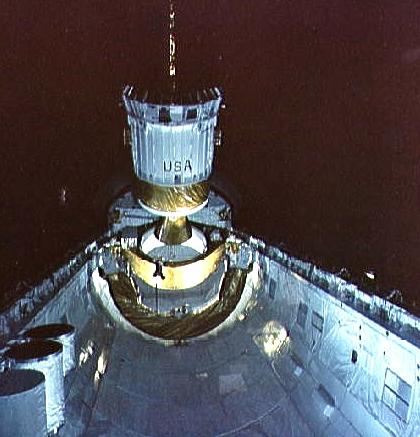
STS-6
Deployment of the TDRS by STS-6 Challenger
Credit: NASA
AKA: Challenger. Launched: 1983-04-04. Returned: 1983-04-09. Number crew: 4 . Duration: 5.02 days.
Payloads: Deployment of Tracking and Data Relay Satellite (TDRS)-A with Inertial Upper Stage (IUS)-2, Continuous Flow Electrophoresis System (CFES), Monodisperse Latex Reactor (MLR), Night/Day Optical Survey of Lightning (NOSL) experiment, three getaway specials (GAS).
Orbits of Earth: 80. Distance traveled: 3,370,437 km. Orbiter Liftoff Mass: 116,457 kg. Orbiter Mass at Landing: 86,330 kg. Payload to Orbit: 21,305 kg. Payload Returned: 4,275 kg. Landed at: Concrete runway 22 at Edwards Air Force Base, Cali. Landing Speed: 352 kph. Touchdown miss distance: 617 m. Landing Rollout: 2,188 m. EVA: Story Musgrave and Donald Peterson, duration 3 hours and 54 minutes.
NASA Official Mission Narrative
Mission Name: STS-6 (6)
CHALLENGER (1)
Pad 39-A (18)
6th Shuttle mission
1st Flight OV-099
1st Shuttle from MLP-2
1st Launch Light Weight External Tank
Crew:
Paul J. Weitz (2), Commander
Karol J. Bobko (1), Pilot
Donald H. Peterson (1), Mission Specialist
F. Story Musgrave (1), Mission Specialist
Milestones:
OPF - July 6, 1982
VAB - Nov. 23, 1982
PAD - Nov. 30, 1982
Payload:
TDRS-A,CFES(2),MLR/NOSL(1),GAS(x3)
Mission Objectives:
Launch:
April 4, 1983, 1:30:00 p.m. EST. Launch set for Jan. 20 postponed due to hydrogen leak into number one main engine aft compartment discovered during 20 second Flight Readiness Firing (FRF) Dec. 18, 1982. Cracks in number one main engine confirmed to be cause of leak during second FRF performed Jan. 25, 1983. All three main engines removed while Shuttle was on the pad and fuel line cracks repaired. Main engines two and three reinstalled following extensive failure analysis and testing. Number one main engine replaced. Additional delay caused by contamination to Tracking and Data Relay Satellite-1 (TDRS-1) during a severe storm. Launch on April 4 proceeded as scheduled. Launch Weight: 256,744 lbs.
Orbit:
Altitude: 178nm
Inclination: 28.5 degrees
Orbits: 81
Duration: 5 days, 2 hours, 14 minutes, 25 seconds
Distance: 2,094,293 miles
Hardware:
SRB: BI-006
SRM: 006LW(SPM)
ET : 8/LWT-1
MLP : 2
SSME-1: SN-2017
SSME-2: SN-2015
SSME-3: SN-2012
Landing:
April 9, 1983, 10:53:42 a.m. PST, Runway 22, Edwards Air Force Base, Calif. Rollout distance 7,180 feet, Rollout time 49 sec. Orbiter returned to KSC April 16, 1983. Landing Weight: 190,330 lbs.
Mission Highlights:
Primary payload was first Tracking and Data Relay Satellite-1
(TDRS-1). Malfunction of Inertial Upper Stage booster resulted in
placement of spacecraft into improper but stable orbit. Additional
propellant aboard satellite used over next several months gradually
place TDRS-1 into properly circularized orbit. First space walk
of Shuttle program performed by Peterson and Musgrave, lasting
about four hours, 17 minutes. Other payloads: Continuous Flow
Electrophoresis System (CFES), Monodisperse Latex Reactor (MLR)
(MLR), Radiation Monitoring Experiment (RME). Night/Day Optical
Survey of Lightning (NOSL), and three Get Away Special canisters.
Mission used first lightweight external tank and lightweight
rocket booster casings.
More at: STS-6.
Family: Manned spaceflight. People: Bobko, Musgrave, Peterson, Weitz. Country: USA. Spacecraft: Challenger. Projects: STS. Launch Sites: Cape Canaveral. Agency: NASA, NASA Houston.
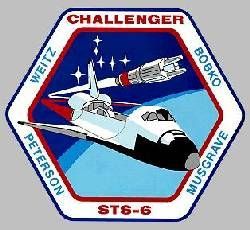 | STS-6 Credit: www.spacefacts.de |
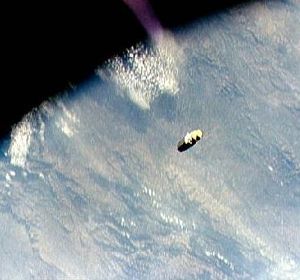 | STS-6 TDRS satellite over African Rift Valley, Kenya, Africa Credit: NASA |
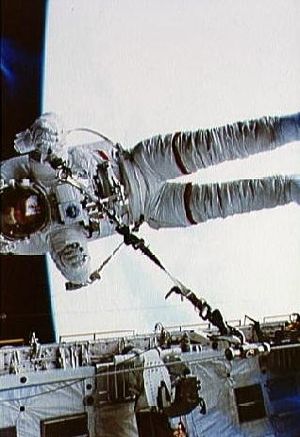 | STS-6 MS Musgrave tethered to starboard sill longeron floats outside PLB Credit: NASA |
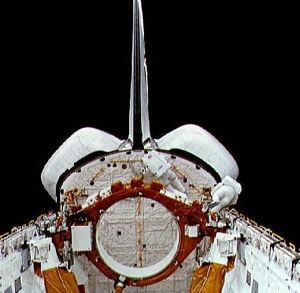 | STS-6 Views of EVA performed during STS-6 Credit: NASA |
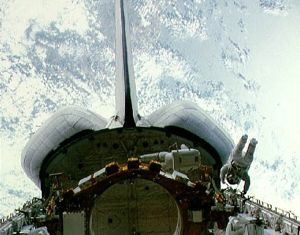 | STS-6 Views of EVA performed during STS-6 Credit: NASA |
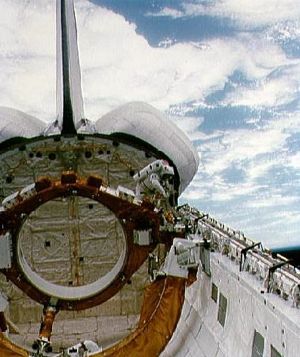 | STS-6 Astronaut Musgrave performing EVA during STS-6 Credit: NASA |
1983 April 4 - . 18:30 GMT - . Launch Site: Cape Canaveral. Launch Complex: Cape Canaveral LC39A. Launch Platform: MLP2. LV Family: Shuttle. Launch Vehicle: Space Shuttle.
- STS-6 - .
Call Sign: Challenger. Crew: Bobko,
Musgrave,
Peterson,
Weitz.
Payload: Challenger F01 / TDRS 1 [IUS]. Mass: 21,305 kg (46,969 lb). Nation: USA.
Related Persons: Bobko,
Musgrave,
Peterson,
Weitz.
Agency: NASA Houston.
Program: STS.
Class: Manned.
Type: Manned spaceplane. Flight: STS-6.
Spacecraft Bus: Shuttle.
Spacecraft: Challenger.
Duration: 5.02 days. Decay Date: 1983-04-09 . USAF Sat Cat: 13968 . COSPAR: 1983-026A. Apogee: 295 km (183 mi). Perigee: 288 km (178 mi). Inclination: 28.50 deg. Period: 90.40 min.
Manned four crew. First flight of space shuttle Challenger; deployed TDRSS. Payloads: Deployment of Tracking and Data Relay Satellite (TDRS)-A with Inertial Upper Stage (lUS)-2, Continuous Flow Electrophoresis System (CFES), Monodisperse Latex Reactor (MLR), Night/Day Optical Survey of Lightning (NOSL) experiment, three getaway specials (GAS).
1983 April 5 - .
- STS-6 - Wakeup Song: Cadets on Parade - . Flight: STS-6. "Cadets on Parade" and The Air Force Song ("Off We Go Into the Wild Blue Yonder") by the United States Air Force Academy Band.
1983 April 6 - .
- STS-6 - Wakeup Song: Teach Me Tiger - . Flight: STS-6. "Teach Me Tiger" by April Stevens.
1983 April 7 - .
- STS-6 - Wakeup Song: Theme from F-Troop - . Flight: STS-6. "Theme from F-Troop" The significance of that being referring to this crew as the F-crew for the purposes of training documents the crews have been listed alphabetically..
1983 April 8 - .
- STS-6 - Wakeup Song: The Poor Co-pilot - . Flight: STS-6. "The Poor Co-pilot" a tune from Korean War flying days sung by Oscar Brand and the Roger Wilco 4.
1983 April 8 - . 21:05 GMT - .
- EVA STS-6-1 - . Crew: Musgrave, Peterson. EVA Duration: 0.17 days. Nation: USA. Related Persons: Musgrave, Peterson. Program: STS. Class: Manned. Type: Manned spaceplane. Flight: STS-6. Spacecraft Bus: Shuttle. Spacecraft: Challenger. Tested EMU Manoeuvring Unit. Tested EVA emergency procedures..
1983 April 9 - .
- STS-6 - Wakeup Song: Ode to the Lions - . Flight: STS-6. "Ode to the Lions" as rendered by Rusty Gordon. This is a Penn State song referring to the Nittany Lions, of Penn State University which is Paul Weitz alma mater. He earned his Bachelor in Aeronautical Engineering at Penn State in 1954..
1983 April 9 - .
- Landing of STS-6 - . Return Crew: Bobko, Musgrave, Peterson, Weitz. Nation: USA. Related Persons: Bobko, Musgrave, Peterson, Weitz. Program: STS. Flight: STS-6. STS-6 landed at 18:53 GMT. .
Back to top of page
Home - Search - Browse - Alphabetic Index: 0- 1- 2- 3- 4- 5- 6- 7- 8- 9
A- B- C- D- E- F- G- H- I- J- K- L- M- N- O- P- Q- R- S- T- U- V- W- X- Y- Z
© 1997-2019 Mark Wade - Contact
© / Conditions for Use